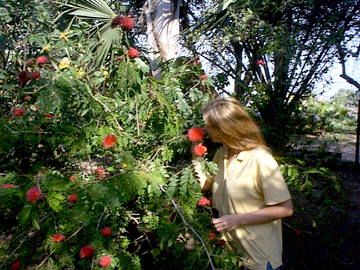
Flowering trees
I have now discussed the common fruit trees and bold leafed plants found in every jungle. There is only one group of plants that I have not described. These need honorable mention since these plants add the fire to the jungle. This is what provides the Latin music to South America, the curry to an east Indian feast, the oasis to the desert, and the handsome features to the macaws. These are the favorites of Tangerine and myself. I am referring to the beautiful flowering trees. These are often giants and these flowering giants provide additional canopy to my jungle.

"Orchid Trees" The orchid trees in bloom are a sight to behold. They have the most luxuriant, 4 to 5 inch blossoms with a fragrance that blends into the February nights. These trees are the largest trees in my front garden. They are intermingled with palms and bougainvillea and are a most tropical sight. A Hong Kong orchid which is located in the back yard is my favorite. It blooms from October through April. It has less litter than the other orchids since it does not develop seeds. It is currently about 15 feet tall but will grow to 40 feet.
"Silk Floss" The favorite of most of Thad's guests is the silk floss although it is commonly referred to as the kapok tree. This 50 foot giant has a trunk which is approximately a foot and half across. The "bark" is dark green and covered with large fat thorns. The green branches cover the tree. In the fall, the tree goes into bloom with large 3 to 3.5 inch pink flowers which look like red tiger lilies. Then the tree goes dormant for the winter. The dormancy corresponds to its dry season in the southern hemisphere where it grows naturally in Brazil and Argentina.

"Silk Oak" The next giant of a tree is the silk oak which grows in Australia. This evergreen tree is the largest tree in our "jungle" approaching 50 to 55 feet. It is having a race with the Mexican fan palms to reach heaven. It produces bottle brush type, golden flowers in early spring. The flowers often are visited by oriels, kiskidees, and sometimes rodents. The seeds are relished by us parrots. The leaves are unique and approximately 6 inches long and 3 inches wide with large indentures from which is gets the name, silk oak. The bottom of the leaf is silver colored.
"Cassia" Another late winter blooming tree is the Cassia splendida or a related variety. This tree has compound leaves that are rarely noticed. It is in close proximity to a ficus and a massive bamboo which seem to steal the attention from this neglected, attractive tree. The blooms are so high up on the tree that they can be missed throughout their life. This tree would receive much more attention if it were not diminished by the nearby foliage and the other trees which bloom throughout the yard at the same time.
 Lori and the Powder
Puff tree
Lori and the Powder
Puff tree
"Yellow poinciana" Another blooming tree which is largely ignored is the Yellow poinciana or the Yellow Flame Tree. This drought tolerant tree is a spectacle in bloom but my lone tree in the garden is being overwhelmed by an orchid tree. Thad has considered removing the orchid tree to allow this tree to display its beauty but he cannot bear to remove the orchid tree. The yellow poinciana has fern type foliage. The flowers grow from 2 to 3 foot panicles of bright yellow which turn into equally attractive reddish brown seed pods.
"Trumpet or Pui Tree" This is a tree that grows to be a giant in its native land, but grows slower and is smaller (approximately 40 feet) under cultivation. It has clusters of small oval leaflets and the flowers are yellow and trumpet shaped. Ours grows by the road for passersby to enjoy. This tree blooms in late winter and early spring.
"Mahoe" This tree is a hibiscus with large, deep green, heart shaped leaves. The tree has spectacular hibiscus type flowers that change colors during the day. The flowers opening in the morning are yellow, by noon they have changed to orange, and in the evening the flowers are crimson to purple. During the winter, the flowers last more than one day thus there can be several flowers with various colors at one time. The tree grows to about 30 feet in height and freezes readily since its home is in Polynesia.